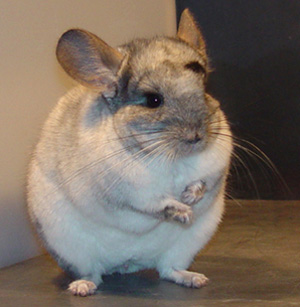
Domestic chinchillas can be kept as pets. Chinchillas are crepuscular, somewhat nocturnal and typically do not like to be disturbed during the day, which may make them less favorable as pets to some people. Chinchillas are naturally very skittish creatures and generally do not like to be held, although they can become very attached to their owners. Because of their high-strung disposition, they are not usually considered to be good pets for small children. However, chinchillas can be very friendly animals if sufficiently acclimated to human touch as kits, making them excellent pets for patient owners.
Captive chinchillas commonly live 15 years, but some have been known to live up to 20 or more.Currently (as of 2008), the world's oldest chinchilla is 27 years old and resides in the UK. The oldest chinchilla in the United States lived to be 26.
Chinchillas make a variety of vocalizations, including chirps, squeaks, and barks. They use these sounds to locate each other and express themselves, from a calm, loving chirp given to a potential mate to a loud, aggressive bark when threatened. Chinchilla kits often greet their parents with a very high pitched chirp, usually to indicate that they are hungry.The first scientific study on chinchilla sounds in their social environment was conducted by Dr. Bartl DVM in Germany. Since they are active at night, it is not uncommon for them to vocalize in the early hours of the morning. If irritated or frightened, the female chinchillas may cluck loudly and spray urine at the offender.
Chinchillas can be housed with others of the same sex; however, it is possible that they may fight. Fighting or getting along depends on the individual animals. If the chinchillas are either introduced when young, or gradually introduced when older, conflict can be reduced. Excessive conflict and violence is dangerous and warring chinchillas must be separated. Males and females usually get along well, although they must be spayed or neutered to avoid reproduction. Typical reproduction rates are two litters per year of 1–3 kits (3 being rare). Male kits must be separated from their mother soon after weaning to prevent mating.
Chinchillas require extensive exercise and should have a large exercise wheel (over 15 in (380 mm) in diameter) with solid surfaces. Chinchilla legs and toes can easily get caught in a mesh running surface and tails can get caught in spokes. Chinchilla teeth need to be worn down as their teeth grow continually and can prevent the chinchilla eating if become overgrown.Wooden sticks, pumice stone and chew toys are good options, but conifer and citrus woods (like cedar or orange) should be avoided because of the high content of resins, oils and phenols that are toxic for chinchillas. Birch, willow, apple tree, manzanita or kiln-dried pine are all safe woods for chinchillas to chew. Chinchillas are voracious chewers and any ingested plastic can cause blockage in the intestines.
The chinchilla lacks the ability to sweat; therefore, if temperatures get above 25°C (80°F), the chinchilla could get overheated and may suffer from heat stroke. Chinchillas dissipate heat by routing blood to their large ears, so red ears signal overheating.
Active and inquisitive by nature, chinchillas need to spend some time outside of the cage to exercise and to satisfy their curiosity.
Chinchillas can be found in a variety of colors including the standard gray (the only color found in nature), beige, white, ebony, and many others. They instinctively clean their fur by taking dust baths, in which they roll around in special chinchilla dust made of fine pumice. In the wild their dust is formed from fine ground volcanic rocks. The dust gets into their fur and absorbs oil and dirt. These baths are needed at least two times a week. Chinchillas do not bathe in water because the dense fur prevents air-drying, retaining moisture close to the skin, which can cause fungus growth or fur rot. A wet chinchilla must be dried immediately with towels and a no-heat hair dryer. The fur is so thick that it resists parasites such as fleas. The fur also reduces loose dander, making chinchillas hypo-allergenic.
Chinchillas must be fed a combination of food pellets and high quality hay (preferably all natural as it is better for them). One to two small treats per day are OK and are a great reward or just a little something to tell your chinchilla that you love them. These treats may be things like raisins, nuts, and a small piece of fruit or vegetable. Specifically they like papaya, apples, carrots, and pears.
Dogs use a healthy instint to be able to munch. Eating washes his or her enamel, beefs up his or her gums, and regulates his or her digestive system state of mind. Eating, trimming, shredding, bringing upward and generally destroying material is usually as standard with regard to puppies because tail-wagging.Pet grooming
ReplyDelete